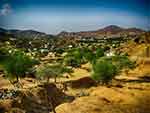
That estimated dollar amount shrank by -19.2% from $411 million five years earlier during 2018.
Year over year, the overall cost of Eritrea’s imported products dropped by -2.2% compared to $339.7 million during 2021.
Eritrea’s biggest spending on imported goods was focused on 5 commodities. These was the highly capital-intensive ships or boats and floating structures, sorghum grain, wheat or meslin flour, sunflower or safflower and cotton-seed oils, and new rubber tires.
Given Eritrea ‘s population of 3.66 million people, its total $332.2 million worth of 2022 imports translates to roughly $160 in yearly product demand from every person in the small African country. That dollar metric eclipses the average $60 per capita one year earlier during 2021.
Eritrea’s Top 10 Imports
The following product groups represent the highest dollar value in Eritrea’s import purchases during 2022, at the 2-digit Harmonized Tariff System (HTS) code level. Also shown is the percentage share each product category represents in terms of overall imports into Eritrea.
- Machinery including computers: US$57.9 million (17.4% of total imports)
- Ships, boats: $29.3 million (8.8%)
- Cereals: $28.3 million (8.5%)
- Milling products, malt, starches: $25.8 million (7.8%)
- Electrical machinery, equipment: $23.2 million (7%)
- Animal/vegetable fats, oils, waxes: $18.4 million (5.5%)
- Vehicles: $15 million (4.5%)
- Rubber, rubber articles: $13.5 million (4.1%)
- Articles of iron or steel: $13.4 million (4%)
- Pharmaceuticals: $12.1 million (3.7%)
Eritrea’s top 10 imports approached three-quarters (71.3%) of the overall value of import products purchased from other countries.
Milling products, malt and starches posted the fastest increase in value among the top 10 import categories, up 49.7% from 2021 to 2022.
In second place for Eritrea’s expanding purchases were imported milling products, malt and starches via a 43.5% advance.
Spending on imported pharmaceuticals appreciated by 31.7% year over year.
Leading the decliners were Eritrea’s import purchases of vehicles, weighed down by a -27.6% reduction compared to 2021.
Please note that the results listed above are at the 2-digit Harmonized Tariff System code level. Information presented under the sections below is at the more granular 4-digit level.
Eritrea’s Top Machinery Imports
In 2022, Eritrean importers spent the most on the following 10 subcategories of machinery including computers.
- Heavy machinery (bulldozers, excavators, road rollers): US$10.9 million (up 174.9% from 2021)
- Machinery parts: $7.9 million (down -17.6%)
- Sort/screen/washing machinery: $5.5 million (up 36.4%)
- Move/grade/scrape/boring machinery: $4.9 million (up 67.7%)
- Derricks, cranes: $4.3 million (up 671.5%)
- Computers, optical readers: $2.9 million (up 26.5%)
- Liquid pumps and elevators: $2.7 million (down -7.3%)
- Centrifuges, filters and purifiers: $2.7 million (down -21%)
- Miscellaneous engines, motors: $2.1 million (down -12%)
- Taps, valves, similar appliances: $1.7 million (up 3%)
Among these import subcategories, Eritrean purchases of derricks and cranes (up 671.5%), heavy machinery including bulldozers, excavators and road rollers (up 174.9%), and moving, grading, scraping and boring machinery (up 67.7%) grew at the fastest pace from 2021 to 2022.
These amounts and the percentage gains within parenthesis clearly show where the strongest demand lies for different types of imported machinery among Eritrean businesses and consumers.
Eritrea’s Top Imports of Ship, Boats and Floating Structures
In 2022, Eritrean importers spent the most on the following subcategory of ships, boats and floating structures.
- Warships, lifeboats: US$29.3 million (2021 data unavailable)
This import subcategory is highly capital intensive and specialized.
Eritrea’s Top Cereals Imports
In 2022, Eritrean importers spent the most on the following subcategories of cereals.
- Sorghum grain: US$27 million (up 27.8% from 2021)
- Wheat: $682,000 (down -95.5%)
- Rice: $446,000 (down -49.8%)
- Corn: $146,000 (up 758.8%)
These amounts and the percentage gains within parenthesis clearly show where the strongest demand lies for different types of imported cereals among Eritrean businesses and consumers.
Eritrea’s Top Milling Product Imports
In 2022, Eritrean importers spent the most on the following subcategories of milling industry goods.
- Wheat or meslin flour: US$22.7 million (up 71% from 2021)
- Malt: $3.1 million (up 66.6%)
- Potato flour, powder, flakes, pellets: $10,000 (2021 data unavailable)
These amounts and the percentage gains within parenthesis clearly show where the strongest demand lies for different types of imported milling industry goods among Eritrean businesses and consumers.
See also Eritrea’s Top 10 Exports, Top African Export Countries and Nigeria’s Top 10 Imports
Research Sources:
Central Intelligence Agency, The World Factbook Country Profiles. Accessed on October 21, 2023
International Monetary Fund, World Economic Outlook Database (GDP based on Purchasing Power Parity). Accessed on October 21, 2023
Trade Map, International Trade Centre, www.intracen.org/marketanalysis. Accessed on October 21, 2023